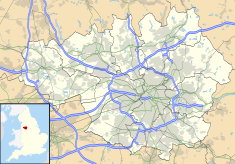2017 fire
On 12 February 2017 the church caught fire, [8] [9] and the fire brigade was called at 11:08 pm. [7] The fire took dozens of firefighters [2] with six fire engines to extinguish. [8] The fire melted gas pipes inside the building, with the subsequent gas ignition causing additional damage to the building. [10] Most of the fire was extinguished in an hour, [11] although firefighters stayed at the site overnight. [2] The roof of the building collapsed during the fire, [8] and the interior was destroyed. [2] The top parts of the gable ends of the building were dismantled to make the building safe. [10]
A fundraising campaign to restore the church was launched after the fire, with the hope that the building can be saved. [11] Canon David Wyatt of the Church of the Ascension, described the fire as hurtful and frustrating but noted the “heart-warming” response from parishioners. [12] Greater Manchester Police investigated the fire. [2] CCTV footage of suspects was released to the public. [13] A 22-year-old man was arrested on suspicion of arson on 17 February, although the origin of the fire remains unknown. [2]
A project to rebuild the church over two years was announced in June 2017. The Church reopened in October 2022, with the licensing of Rev Canon Falak Sher, with over 200 people in the congregation. [14]
The New Pipe Organ.
The previous organ, a 2 manual tracker Jardine's instrument, was destroyed in the fire.
The New instrument was installed by the Nottingham based firm, Henry Groves & Sons. It is a 3 manual electro-magnetic organ which boasts 53 speaking stops over 3 manuals and pedal board. It is a far superior instrument, the first Henry Groves instrument in Manchester, and the North West.

